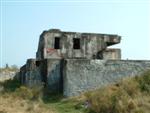
|
Emperor Wang
    
location:
On an island, in a river

Fetish? What fetish?
 | |  | Lou Collins, 85, Halifax Heritage Activist
< on 1/11/2008 2:42 AM >
|  | | | I thought some of the Halifax people might appreciate this obituary from last Saturday's Globe and Mail. What little remains of the historic Halifax waterfront is due in large part to the efforts of Lou Collins.
School principal fought to save Halifax waterfront from destruction
Worried that old structures were to be replaced by a freeway, he mounted a dogged 10-year campaign that resulted in seven heritage buildings being declared a national historic site
ALLISON LAWLOR
Special to The Globe and Mail
January 8, 2008
HALIFAX -- Perhaps the best-known champion of Halifax's heritage, Lou Collins was so passionate about the city's historic buildings that he once faced down a bulldozer ready to demolish a waterfront structure dating back to the early 1800s.
While he wasn't able to save that particular building from destruction, his years of fighting developers and city council are credited for preserving a collection of structures on the city's waterfront where privateers are said to have stored their booty in the War of 1812, and where Alexander Keith started brewing his ale in 1820.
When Mr. Collins heard that some of the waterfront buildings were slated for demolition in the early 1960s to make way for a harbour freeway, he entered into what would become more than a decade-long battle to save the structures. Eventually, they were declared a national historic site.
"The name Lou Collins is synonymous with heritage preservation in Nova Scotia," said Philip Pacey, president of the Heritage Trust of Nova Scotia.
As a board member of the trust, Mr. Collins asked councillor Allan O'Brien (who later become Halifax's mayor) to present a proposal to city council calling for the preservation of a group of historical buildings on the waterfront. While the council agreed to set aside the proposal, Mr. Collins and a team of volunteers vowed not to let the issue die. His team included Allan Duffus, a well-known Halifax architect, and Gil Hutton. "We mounted huge efforts," said Mr. Hutton, a retired scientist. "Sometimes, we were working till midnight, night after night."
Mr. Collins, who once told a reporter he considered heritage issues "a helluva lot of fun," was keenly aware that what they really needed to save the buildings was hefty political support.
"Those buildings will only be saved if the councillors say they should be saved," he was fond of repeating. "If you don't win the political battle, you'll lose all the others."
It was a lesson that others learned only too well. "If he hadn't done that, the waterfront buildings wouldn't be there," Mr. Hutton said. "I think the whole rejuvenation of the city came from saving those buildings."
Mr. Collins eventually persuaded Mr. O'Brien to set up an advisory committee on the preservation of historic buildings. Once appointed chairman, Mr. Collins pushed for a stronger body with more clout. He got one in 1970 when the Halifax Landmarks Commission was created. He also became its first chairman. After much work, the commission persuaded city council to abandon the plan for a waterfront freeway.
Finally, in June of 1975, Historic Properties was opened to the Halifax public. To recapture their former beauty, many of the buildings it embraced had to be stripped down to their wood-and-stone skeletons. Today, the seven restored buildings house trendy boutiques and fashionable restaurants and pubs.
"It was a turning point in how Halifax viewed its historic buildings," Mr. Pacey said, adding that "a lot of places across the country looked to Historic Properties as an example."
Mr. Collins felt that Halifax lagged behind many North American cities in its urban renewal efforts. When the city finally got around to rebuilding its decaying city core, he said, it imported the worst aspects of renewal by bulldozing many old structures, a move he described as being more destructive than the 1917 Halifax Explosion.
"It's rather a depressing story here," he told The Globe and Mail in 1978. "We've won some battles and lost quite a few. Part of the problem is that people thought for many years that we had so many historic buildings, losing a few didn't matter."
Born on Halifax's Liverpool Street, Louis Collins spent most of his adult years in a house behind the one in which he was born. The area around his childhood home was mostly farm fields until the Second World War, when prefabricated houses suddenly appeared.
Mr. Collins's interest in history stemmed from his parents, William and Amy Collins. By all accounts, they were wonderful storytellers who often recounted family tales that dated back hundreds of years to England and Scotland. As a child, Mr. Collins and his brother Laurence, who was killed in 1943 during active duty with the Royal Canadian Air Force, used to roam the fields near their home. One day, his brother found a blade from a farm knife. He gave it to the curator of the Nova Scotia Museum and, to their delight, it was put on exhibit. They also loved to go to the city's waterfront with their father to check which ships had entered the harbour.
At Dalhousie University, he earned a master's degree in English, with a minor in history, and then an education diploma. At university, he was literary editor of a school newspaper and was encouraged to pursue a career in journalism. He chose teaching, instead.
After a year at King's Collegiate in Windsor, N.S., he entered the Halifax school system in 1950 to teach at Richmond Junior High. He then spent more than 20 years as a teacher and vice-principal at Westmount Elementary-Junior High before joining Cornwallis Junior High School. He retired as principal of Cornwallis in 1983. He coached hockey, basketball and swimming, acted as part-time probation officer and was a troop leader with Scouts Canada. He also was a founding member of the Nova Scotia teachers union.
"He was a very good storyteller," said his wife, Pamela. "I don't think I ever heard any of his kids or students say they had a boring history lesson."
Mr. Collins met his future bride through scouting. Pamela, then a young English immigrant, was a Girl Guides of Canada leader. They married in 1955 in Halifax and had three daughters.
Early in his teaching career, he started taking students on walks around the city. "I've been like the Pied Piper at times," he told Rosemary Bauchman in her book Scotia Story Tellers: Personal Glimpses of 21 Nova Scotia Writers, "with as many as 150 children on the walks."
Throughout his life, he lead countless walking tours of the Halifax historic core and, in 1975, he privately published a book called In Halifax Town. He also wrote several articles, and produced a column for the Halifax community publication Southender.
"He loved to tell stories of the history of Halifax," Mr. Pacey said. "He had an infectious way of being able to bring people in and have them become interested."
Mr. Collins and his wife joined the Heritage Trust of Nova Scotia soon after it was formed in 1959. The first task on the agenda was to save the home of Enos Collins, a Nova Scotian privateer who, at his death in 1871, was said to be the richest man in Canada. Their efforts failed, and the Georgian-style home was torn down. Saint Mary's University's hockey rink now stands in its place.
"People thought I was a descendant of Enos Collins and was trying to preserve my progenitor, but I wasn't," he told Ms. Bauchman. "He was not a relative. There are people, families in Halifax who still bristle at the name of Collins. He was a hard-nosed old businessman, a former privateer. I had a very difficult time in the beginning because of him!"
Around that time, Mr. Collins and artist John Cook decided to collaborate on a book about notable buildings in Halifax.
"When I checked the buildings John had painted, I found that many were due to be demolished," he told Ms. Bauchman. "I'd grown up in the city and knew Water Street as a boy. I felt that the Water Street I knew was about to disappear."
Aside from his vigorous fight to save the waterfront buildings, Mr. Collins was among the first to point out that tall buildings were beginning to obstruct the view of the harbour from the Halifax Citadel. The city now has zoning bylaws that state all new buildings should not block the view to the harbour from the Citadel, a historic fortress completed by the British in 1856.
Eventually named the city's honorary civic historian, Mr. Collins was a man driven to look for history in everything. While serving as chair of the Halifax Landmarks Commission, it was his habit to request the latest stack of demolition permits. "If I thought the building was of some interest, I'd take a wrecking bar at noon hour and go around ripping out the soot doors [from chimneys] to save the marks from the local foundries," he told The Chronicle Herald in 1996. "It was my entertainment."
In 1979, Mr. Collins received an honorary doctorate of fine arts from the Nova Scotia College of Art and Design (now NSCAD University) for his work to protect Halifax's heritage. In May of 1996, he was appointed a member of the Order of Canada. While in Ottawa to receive his honour, Mr. Collins stumbled on what he considered a great find.
"Among my obsessions and compulsions is an inclination to pick up screws and nails from roads and sidewalks," he wrote in a 1996 column in the Southender. "On the path beside the East Block, I found a bright new metal screw. On closer examination, it proved to be a Robertson screw, that unique Canadian invention that responds readily to the additional torque that can be applied by a Robertson screwdriver with its square head."
It's great to be alive! |
|
darbycrashin
     
Noble Donor
location:
Halifax, Nova Scotia
Gender: Female
 | |  | Re: Lou Collins, 85, Halifax Heritage Activist
<Reply # 1 on 1/11/2008 3:18 AM >
|  | | | indeed, we owe a lot to Collins, thanks for the article.
Flickr http://flickr.com/photos/klandry |
|
N250cc
  
location:
Halifax, NS
Gender: Male

 | |  | |  | Re: Lou Collins, 85, Halifax Heritage Activist
<Reply # 2 on 1/27/2008 3:56 AM >
|  | | | Good read, he's done a lot for the city, thanks
|
|
Powered by AvBoard AvBoard version 1.5 alpha
Page Generated In: 62 ms
|
|

